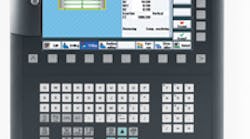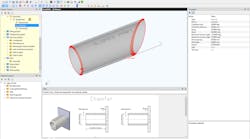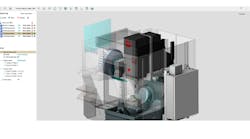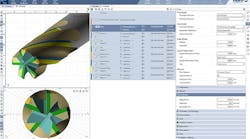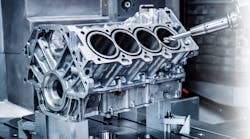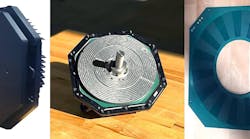Siemens Drive Technologies is targeting job-shop operations with its new control architecture, Sinumerik 828D, that it says will free shops from G-code-intensive programming. The package combines CNC, PLC, and axis control for six CNC measurement circuits, and presents these in one operator panel. Siemens states that Sinumerik 828D offers users “intelligent kinematic transformations, an efficient tool management system and 80-bit floating point nano precision.”
The new platform was given an extensive trial at HBH Enterprise, a full-service, Asheville, N.C., shop where milling and turning machines manufacture parts for automotive, aerospace, medical, construction equipment, textile, plastic, and paper mill equipment manufacturers.
Siemens approached HBH Enterprise in mid 2008, after a nationwide search for the prototypical American job shop that would become one of a select number of beta test sites for a new CNC platform.
HBH owner John Lydecker said that the opportunity to test the new CNC on a variety of milling and turning machine tools “changed our view of the machine tool industry and certainly changed our company. This new platform has proven beneficial not only to our operators, but also to management, as it provides unparalleled levels of machine monitoring and production tracking.”
Lydecker noted that for years HBH had used an older, well-accepted brand of CNC. “Many brands have made substantial jumps in graphical user interface (GUI) over the years, but all relied on the conventional G-code model. This new CNC leaps ahead in unprecedented ways. The extremely logical, yet plain language, interface is designed for easy, operator machine set-up and production adjustments. Instead of five steps, for example, a command sequence often requires just two steps. Plus, the control guides the operator with fully animated cutting sequences to quickly and easily visualize the tool path.”
Sinumerik 828D presents users with a graphical interface, but also is capable of advanced language command. It supports ISO programming, too, so it’s compatible with practically any CNC programming developed by any machine builder.
The program’s functionality covers milling and turning for single-part and small-batch production or high-volume serial manufacturing. The milling version of Sinumerik 828D is targeted at vertical machining centers, with add-ons like an A-axis for machining cylindrical workpieces or a swivel unit for machining inclined workpiece planes. Advanced Surface, the program’s path-guidance system, improves machining of high-precision molds.
Sinumerik 828D also adapts to turning operations, specifically on single-channel lathes. For face and outer surface machining, the system supports a fully functional counter spindle — with or without a Y-axis. In both the milling and turning applications, the system parameters are pre-defined, so commissioning time is minimal. Machine builders can simplify the program extension to other components (e.g., indexing tables, bar loaders) using the Easy Extend module. CNC expertise is not required.
ShopMill and ShopTurn graphical programming systems are other options for smooth programming in a job-shop setting. In large-scale serial production, high-level language programming, in conjunction with programGuide for technology cycle parameterization, significantly reduces programming times.
With either horizontal or vertical panel arrangement and a choice of two CNC standards, Sinumerik 828D users can apply it to their machine and performance: allowing the control to be adapted to each user’s specific mounting site and individual machine performance requirements.
As HBH’s chief application engineer and lead man, Daniel Faciliendo has run many machine tools with various CNC brands onboard. Asked about the new Siemens CNC, he said: “Advanced Surface alone is most impressive. The new level of algorithms in this control helped us to achieve our desired part-surface finishes in record time.” He cited an example of line-by-line milling, where the CNC calculated the forward and backward path motions identically, and displayed them instantly.
As for the impact on HBH’s operators, Faciliendo noted: “The control’s video-like imagery goes substantially beyond the simple graphical-based programming and operating systems of the past. This helps us to reduce training, accelerates set-up times, and increases the machine throughput here at HBH by factors we’ve yet to calculate completely.
Faciliendo confirmed that the shop’s overall performance has improved, as operators now can “see the difference between chip-breaking and stock removal when drilling, or they can see the exact tracing sequence on a cornering maneuver. Mistakes are therefore eliminated before they occur and in an unbelievably short time period,” he concluded.
